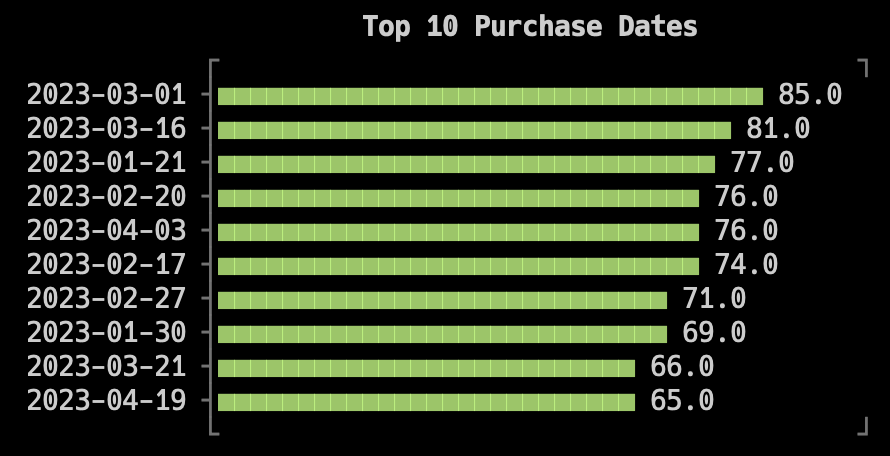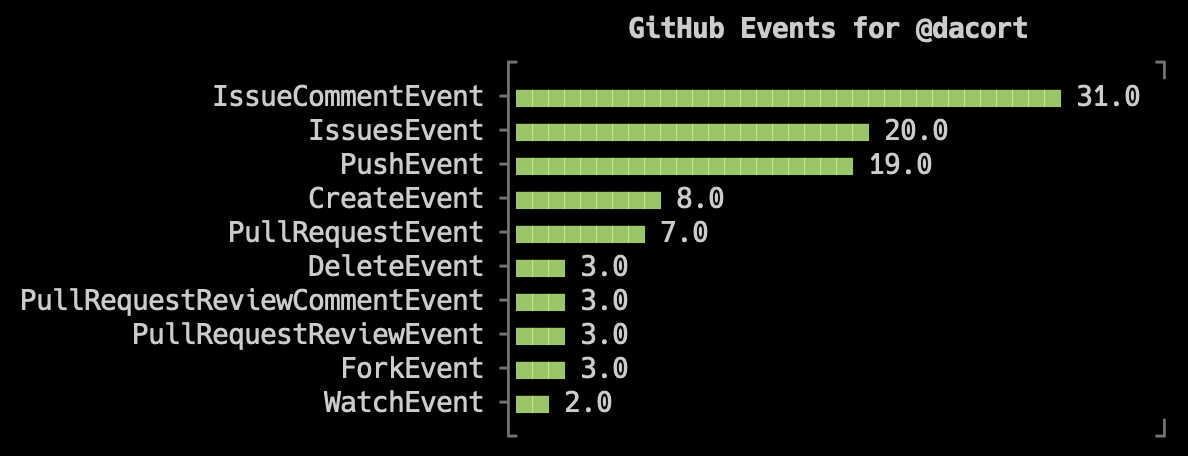- Installation
- Documentation
- Overview
- Connect
- Data Import
- Overview
- CSV Files
- JSON Files
- Multiple Files
- Parquet Files
- Partitioning
- Appender
- INSERT Statements
- Client APIs
- Overview
- C
- Overview
- Startup
- Configuration
- Query
- Data Chunks
- Values
- Types
- Prepared Statements
- Appender
- Table Functions
- Replacement Scans
- API Reference
- C++
- CLI
- Go
- Java
- Julia
- Node.js
- Python
- Overview
- Data Ingestion
- Conversion between DuckDB and Python
- DB API
- Relational API
- Function API
- Types API
- Expression API
- Spark API
- API Reference
- Known Python Issues
- R
- Rust
- Swift
- Wasm
- ADBC
- ODBC
- Configuration
- SQL
- Introduction
- Statements
- Overview
- ANALYZE
- ALTER TABLE
- ALTER VIEW
- ATTACH/DETACH
- CALL
- CHECKPOINT
- COMMENT ON
- COPY
- CREATE INDEX
- CREATE MACRO
- CREATE SCHEMA
- CREATE SECRET
- CREATE SEQUENCE
- CREATE TABLE
- CREATE VIEW
- CREATE TYPE
- DELETE
- DESCRIBE
- DROP
- EXPORT/IMPORT DATABASE
- INSERT
- PIVOT
- Profiling
- SELECT
- SET/RESET
- SUMMARIZE
- Transaction Management
- UNPIVOT
- UPDATE
- USE
- VACUUM
- Query Syntax
- SELECT
- FROM & JOIN
- WHERE
- GROUP BY
- GROUPING SETS
- HAVING
- ORDER BY
- LIMIT and OFFSET
- SAMPLE
- Unnesting
- WITH
- WINDOW
- QUALIFY
- VALUES
- FILTER
- Set Operations
- Prepared Statements
- Data Types
- Overview
- Array
- Bitstring
- Blob
- Boolean
- Date
- Enum
- Interval
- List
- Literal Types
- Map
- NULL Values
- Numeric
- Struct
- Text
- Time
- Timestamp
- Time Zones
- Union
- Typecasting
- Expressions
- Overview
- CASE Statement
- Casting
- Collations
- Comparisons
- IN Operator
- Logical Operators
- Star Expression
- Subqueries
- Functions
- Overview
- Array Functions
- Bitstring Functions
- Blob Functions
- Date Format Functions
- Date Functions
- Date Part Functions
- Enum Functions
- Interval Functions
- Lambda Functions
- Nested Functions
- Numeric Functions
- Pattern Matching
- Regular Expressions
- Text Functions
- Time Functions
- Timestamp Functions
- Timestamp with Time Zone Functions
- Utility Functions
- Aggregate Functions
- Constraints
- Indexes
- Information Schema
- Metadata Functions
- Keywords and Identifiers
- Samples
- Window Functions
- PostgreSQL Compatibility
- Extensions
- Overview
- Official Extensions
- Working with Extensions
- Versioning of Extensions
- Arrow
- AutoComplete
- AWS
- Azure
- Excel
- Full Text Search
- httpfs (HTTP and S3)
- Iceberg
- ICU
- inet
- jemalloc
- JSON
- MySQL
- PostgreSQL
- Spatial
- SQLite
- Substrait
- TPC-DS
- TPC-H
- VSS
- Guides
- Overview
- Data Viewers
- Database Integration
- File Formats
- Overview
- CSV Import
- CSV Export
- Directly Reading Files
- Excel Import
- Excel Export
- JSON Import
- JSON Export
- Parquet Import
- Parquet Export
- Querying Parquet Files
- Network & Cloud Storage
- Overview
- HTTP Parquet Import
- S3 Parquet Import
- S3 Parquet Export
- S3 Iceberg Import
- S3 Express One
- GCS Import
- Cloudflare R2 Import
- DuckDB over HTTPS/S3
- Meta Queries
- Describe Table
- EXPLAIN: Inspect Query Plans
- EXPLAIN ANALYZE: Profile Queries
- List Tables
- Summarize
- DuckDB Environment
- ODBC
- Performance
- Overview
- Import
- Schema
- Indexing
- Environment
- File Formats
- How to Tune Workloads
- My Workload Is Slow
- Benchmarks
- Python
- Installation
- Executing SQL
- Jupyter Notebooks
- SQL on Pandas
- Import from Pandas
- Export to Pandas
- Import from Numpy
- Export to Numpy
- SQL on Arrow
- Import from Arrow
- Export to Arrow
- Relational API on Pandas
- Multiple Python Threads
- Integration with Ibis
- Integration with Polars
- Using fsspec Filesystems
- SQL Editors
- SQL Features
- Snippets
- Development
- DuckDB Repositories
- Testing
- Overview
- sqllogictest Introduction
- Writing Tests
- Debugging
- Result Verification
- Persistent Testing
- Loops
- Multiple Connections
- Catch
- Profiling
- Release Calendar
- Building
- Overview
- Build Instructions
- Build Configuration
- Building Extensions
- Supported Platforms
- Troubleshooting
- Benchmark Suite
- Internals
- Sitemap
- Why DuckDB
- Media
- FAQ
- Code of Conduct
- Live Demo
DuckDB can be used with CLI graphing tools to quickly pipe input to stdout to graph your data in one line.
YouPlot is a Ruby-based CLI tool for drawing visually pleasing plots on the terminal. It can accept input from other programs by piping data from stdin. It takes tab-separated (or delimiter of your choice) data and can easily generate various types of plots including bar, line, histogram and scatter.
With DuckDB, you can write to the console (stdout) by using the TO '/dev/stdout' command. And you can also write comma-separated values by using WITH (FORMAT 'csv', HEADER).
Installing YouPlot
Installation instructions for YouPlot can be found on the main YouPlot repository. If you're on a Mac, you can use:
brew install youplot
Run uplot --help to ensure you've installed it successfully!
Piping DuckDB Queries to stdout
By combining the COPY...TO function with a CSV output file, data can be read from any format supported by DuckDB and piped to YouPlot. There are three important steps to doing this.
-
As an example, this is how to read all data from
input.json:duckdb -s "SELECT * FROM read_json_auto('input.json')" -
To prepare the data for YouPlot, write a simple aggregate:
duckdb -s "SELECT date, sum(purchases) AS total_purchases FROM read_json_auto('input.json') GROUP BY 1 ORDER BY 2 DESC LIMIT 10" -
Finally, wrap the
SELECTin theCOPY ... TOfunction with an output location of/dev/stdout.The syntax looks like this:
COPY (⟨query⟩) TO '/dev/stdout' WITH (FORMAT 'csv', HEADER);The full DuckDB command below outputs the query in CSV format with a header:
duckdb -s "COPY (SELECT date, sum(purchases) AS total_purchases FROM read_json_auto('input.json') GROUP BY 1 ORDER BY 2 DESC LIMIT 10) TO '/dev/stdout' WITH (FORMAT 'csv', HEADER)"
Connecting DuckDB to YouPlot
Finally, the data can now be piped to YouPlot! Let's assume we have an input.json file with dates and number of purchases made by somebody on that date. Using the query above, we'll pipe the data to the uplot command to draw a plot of the Top 10 Purchase Dates
duckdb -s "COPY (SELECT date, sum(purchases) AS total_purchases FROM read_json_auto('input.json') GROUP BY 1 ORDER BY 2 DESC LIMIT 10) TO '/dev/stdout' WITH (FORMAT 'csv', HEADER)" | uplot bar -d, -H -t "Top 10 Purchase Dates"
This tells uplot to draw a bar plot, use a comma-seperated delimiter (-d,), that the data has a header (-H), and give the plot a title (-t).

Bonus Round! stdin + stdout
Maybe you're piping some data through jq. Maybe you're downloading a JSON file from somewhere. You can also tell DuckDB to read the data from another process by changing the filename to /dev/stdin.
Let's combine this with a quick curl from GitHub to see what a certain user has been up to lately.
curl -sL "https://api.github.com/users/dacort/events?per_page=100" | duckdb -s "COPY (SELECT type, count(*) AS event_count FROM read_json_auto('/dev/stdin') GROUP BY 1 ORDER BY 2 DESC LIMIT 10) TO '/dev/stdout' WITH (FORMAT 'csv', HEADER)" | uplot bar -d, -H -t "GitHub Events for @dacort"

